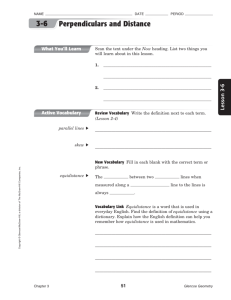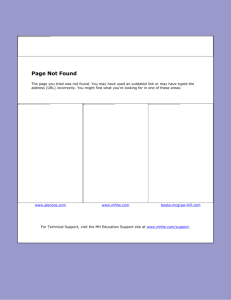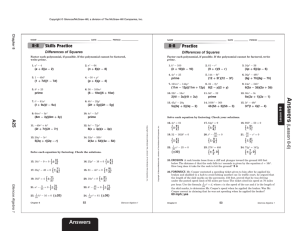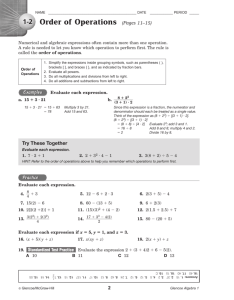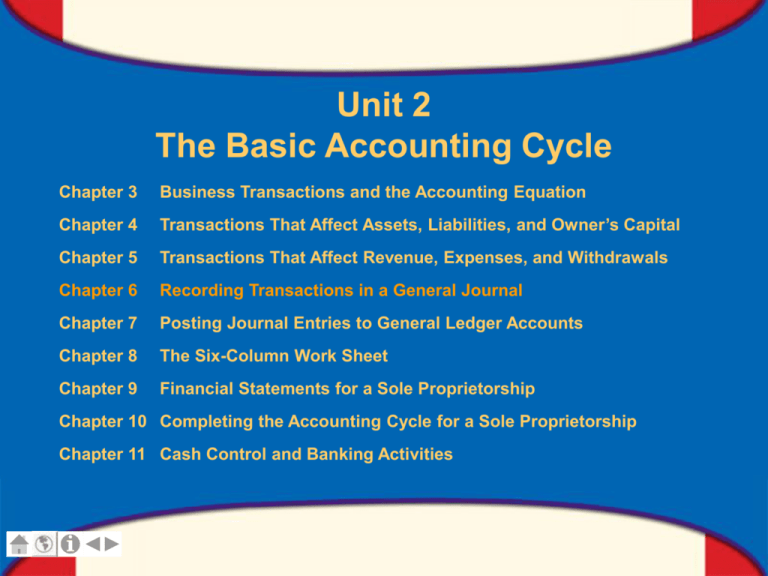
Unit 2
The Basic Accounting Cycle
Chapter 3
Business Transactions and the Accounting Equation
Chapter 4
Transactions That Affect Assets, Liabilities, and Owner’s Capital
Chapter 5
Transactions That Affect Revenue, Expenses, and Withdrawals
Chapter 6
Recording Transactions in a General Journal
Chapter 7
Posting Journal Entries to General Ledger Accounts
Chapter 8
The Six-Column Work Sheet
Chapter 9
Financial Statements for a Sole Proprietorship
Chapter 10 Completing the Accounting Cycle for a Sole Proprietorship
Chapter 11 Cash Control and Banking Activities
Glencoe Accounting Unit 2 Chapter 6 Copyright © by The McGraw-Hill Companies, Inc. All rights reserved.
0
Chapter 6
Recording Transactions in a
General Journal
What You’ll Learn
Explain the first three steps in the accounting cycle.
Give and describe several examples of source
documents.
Explain the purpose of journalizing.
Apply information from source documents.
Describe the steps to make a general journal entry.
Make general journal entries.
Correct errors in general journal entries.
Define the accounting terms introduced in this
chapter.
Glencoe Accounting Unit 2 Chapter 6 Copyright © by The McGraw-Hill Companies, Inc. All rights reserved.
1
Chapter 6, Section 1
The Accounting Cycle
What Do You Think?
What happens if you do not keep financial records in an
orderly fashion?
Glencoe Accounting Unit 2 Chapter 6 Copyright © by The McGraw-Hill Companies, Inc. All rights reserved.
2
SECTION 6.1
The Accounting Cycle
Main Idea
The accounting cycle is a series of steps done in each
accounting period to keep records in an orderly fashion.
You Will Learn
the steps in the accounting cycle.
the different types of accounting periods.
Glencoe Accounting Unit 2 Chapter 6 Copyright © by The McGraw-Hill Companies, Inc. All rights reserved.
3
The Accounting Cycle
SECTION 6.1
Key Terms
accounting cycle
source document
invoice
receipt
memorandum
check stub
journal
journalizing
fiscal year
calendar year
Glencoe Accounting Unit 2 Chapter 6 Copyright © by The McGraw-Hill Companies, Inc. All rights reserved.
4
SECTION 6.1
The Accounting Cycle
The Steps of the Accounting Cycle
The accounting cycle, the activities a business
undertakes to keep its accounting records in an orderly
fashion, consists of nine steps. This chapter will cover
steps 1, 2, and 3:
Collect and verify source documents.
Analyze each transaction.
Journalize each transaction.
Glencoe Accounting Unit 2 Chapter 6 Copyright © by The McGraw-Hill Companies, Inc. All rights reserved.
5
SECTION 6.1
The Accounting Cycle
The Steps of the Accounting Cycle
Glencoe Accounting Unit 2 Chapter 6 Copyright © by The McGraw-Hill Companies, Inc. All rights reserved.
6
SECTION 6.1
The Accounting Cycle
The First Step in the Accounting Cycle:
Collecting and Verifying Source Documents
A business has several transactions that take place daily. A
source document is created for each business transaction.
Commonly used source documents are:
an invoice
a receipt
a memorandum
a check stub
Glencoe Accounting Unit 2 Chapter 6 Copyright © by The McGraw-Hill Companies, Inc. All rights reserved.
7
SECTION 6.1
The Accounting Cycle
The Second Step in the Accounting Cycle:
Analyzing Business Transactions
Determine the debit and credit portions of each transaction
by analyzing the source document. In the real world, you
must examine this document to determine what happened
in a business transaction.
Glencoe Accounting Unit 2 Chapter 6 Copyright © by The McGraw-Hill Companies, Inc. All rights reserved.
8
SECTION 6.1
The Accounting Cycle
The Third Step in the Accounting Cycle:
Recording Business Transactions in a Journal
Now the complete details of each transaction must be
entered in a journal, a record of the transactions of a
business. This is called journalizing.
A journal can also be called the book of original entry.
Glencoe Accounting Unit 2 Chapter 6 Copyright © by The McGraw-Hill Companies, Inc. All rights reserved.
9
SECTION 6.1
The Accounting Cycle
The Accounting Period
The accounting period is the length of time that
accounting records cover. A 12 month period is called a
fiscal year. If the fiscal year spans from January 1 to
December 31, it is a calendar year.
Glencoe Accounting Unit 2 Chapter 6 Copyright © by The McGraw-Hill Companies, Inc. All rights reserved.
10
SECTION 6.1
The Accounting Cycle
Key Terms Review
accounting cycle
Activities performed in an accounting period that
help the business keep its records in an orderly
fashion.
source document
A paper prepared as the evidence that a
transaction occurred.
invoice
A source document that lists the quantity,
description, unit price, and total cost of the items
sold and shipped to a buyer.
Glencoe Accounting Unit 2 Chapter 6 Copyright © by The McGraw-Hill Companies, Inc. All rights reserved.
11
SECTION 6.1
The Accounting Cycle
Key Terms Review
receipt
A source document that serves as a record of
cash received.
memorandum
A brief written message that describes a
transaction that takes place within a business.
check stub
A source document that lists the same information
that appears on a check and shows the balance
in the checking account before and after each
check is written.
Glencoe Accounting Unit 2 Chapter 6 Copyright © by The McGraw-Hill Companies, Inc. All rights reserved.
12
SECTION 6.1
The Accounting Cycle
Key Terms Review
journal
A chronological record of the transactions of a
business.
journalizing
The process of recording business transactions.
fiscal year
An accounting period of twelve months.
calendar year
Accounting period that begins on January 1 and
ends on December 31.
Glencoe Accounting Unit 2 Chapter 6 Copyright © by The McGraw-Hill Companies, Inc. All rights reserved.
13
Chapter 6, Section 2
Recording Transactions in the
General Journal
What Do You Think?
Why do you need to record transactions?
Glencoe Accounting Unit 2 Chapter 6 Copyright © by The McGraw-Hill Companies, Inc. All rights reserved.
14
SECTION 6.2
Recording Transactions in the
General Journal
Main Idea
You can use the general journal to record all of the
transactions of a business.
You Will Learn
how to record a general journal entry.
how to correct errors in the general journal.
Glencoe Accounting Unit 2 Chapter 6 Copyright © by The McGraw-Hill Companies, Inc. All rights reserved.
15
SECTION 6.2
Recording Transactions in the
General Journal
Key Term
general journal
Glencoe Accounting Unit 2 Chapter 6 Copyright © by The McGraw-Hill Companies, Inc. All rights reserved.
16
SECTION 6.2
Recording Transactions in the
General Journal
Recording a General Journal Entry
The most common accounting journal is the general
journal, in which all of the transactions of a business
may be recorded. The general journal has two columns:
the left column for recording debits
the right column for recording credits
Glencoe Accounting Unit 2 Chapter 6 Copyright © by The McGraw-Hill Companies, Inc. All rights reserved.
17
SECTION 6.2
Recording Transactions in the
General Journal
Recording a General Journal Entry
This is an example of a general journal entry:
Glencoe Accounting Unit 2 Chapter 6 Copyright © by The McGraw-Hill Companies, Inc. All rights reserved.
18
SECTION 6.2
Recording Transactions in the
General Journal
Recording a General Journal Entry
There are seven steps to determining each journal entry:
Identify the accounts affected.
Classify the accounts affected.
Determine the amount of increase or decrease for
each account affected.
Determine which accounts are debited and for
what amount.
Determine which accounts are credited and for
what amount.
Determine the complete entry in T-account form.
Determine the complete entry in general journal
entry form.
Glencoe Accounting Unit 2 Chapter 6 Copyright © by The McGraw-Hill Companies, Inc. All rights reserved.
19
SECTION 6.2
Recording Transactions in the
General Journal
Recording a General Journal Entry
Here is an example showing the analysis of a business
transaction and its general journal entry:
Glencoe Accounting Unit 2 Chapter 6 Copyright © by The McGraw-Hill Companies, Inc. All rights reserved.
20
SECTION 6.2
Recording Transactions in the
General Journal
Recording a General Journal Entry
Here is an example showing the analysis of a business
transaction and its general journal entry:
Glencoe Accounting Unit 2 Chapter 6 Copyright © by The McGraw-Hill Companies, Inc. All rights reserved.
21
SECTION 6.2
Recording Transactions in the
General Journal
Recording a General Journal Entry
Here is an example showing the analysis of a business
transaction and its general journal entry:
Glencoe Accounting Unit 2 Chapter 6 Copyright © by The McGraw-Hill Companies, Inc. All rights reserved.
22
SECTION 6.2
Recording Transactions in the
General Journal
Recording a General Journal Entry
Here is an example showing the analysis of a business
transaction and its general journal entry:
Glencoe Accounting Unit 2 Chapter 6 Copyright © by The McGraw-Hill Companies, Inc. All rights reserved.
23
SECTION 6.2
Recording Transactions in the
General Journal
Correcting the General Journal
If an error is found, it must be corrected.
Do not erase an error. Draw a line through it with a pen
and enter the correct information above the line.
Glencoe Accounting Unit 2 Chapter 6 Copyright © by The McGraw-Hill Companies, Inc. All rights reserved.
24
SECTION 6.2
Recording Transactions in the
General Journal
Key Term Review
general journal
An all-purpose journal in which all the
transactions of a business may be recorded.
Glencoe Accounting Unit 2 Chapter 6 Copyright © by The McGraw-Hill Companies, Inc. All rights reserved.
25
CHAPTER 6
Chapter 6 Review
Problem 1
Describe the general journal entry for the following event.
On January 16, 20-- On Time Delivery issued Check 243
to Comfort Space for $4,000 to buy office furniture.
(continued)
Glencoe Accounting Unit 2 Chapter 6 Copyright © by The McGraw-Hill Companies, Inc. All rights reserved.
26
CHAPTER 6
Chapter 6 Review
Answer 1
First record:
The date in the Date Column
20-Jan. 16
(continued)
Glencoe Accounting Unit 2 Chapter 6 Copyright © by The McGraw-Hill Companies, Inc. All rights reserved.
27
Answer 1
Then record:
The account debited in the Description column
The amount of the debit in the Debit column
20-Jan. 16 Office Furniture
4 0 0 0 00
(continued)
Glencoe Accounting Unit 2 Chapter 6 Copyright © by The McGraw-Hill Companies, Inc. All rights reserved.
28
CHAPTER 6
Chapter 6 Review
Answer 1
Then record:
The account credited in the Description column. The
account name is indented under the debit account name.
The amount of the credit in the Credit Column.
20-Jan. 16 Office Furniture
Cash in Bank
4 0 0 0 00
4 0 0 0 00
(continued)
Glencoe Accounting Unit 2 Chapter 6 Copyright © by The McGraw-Hill Companies, Inc. All rights reserved.
29
CHAPTER 6
Chapter 6 Review
Answer 1
Finally, in the Description column, record:
An explanation. Indent the explanation under the
credit account name.
20-Jan. 16 Office Furniture
Cash in Bank
Check 243
4 0 0 0 00
Glencoe Accounting Unit 2 Chapter 6 Copyright © by The McGraw-Hill Companies, Inc. All rights reserved.
4 0 0 0 00
30
CHAPTER 6
Chapter 6 Review
Question 2
Why do businesses separate their accounting records
into accounting periods?
Glencoe Accounting Unit 2 Chapter 6 Copyright © by The McGraw-Hill Companies, Inc. All rights reserved.
31
CHAPTER 6
Chapter 6 Review
Answer 2
Businesses use accounting periods to make financial
comparisons possible. Comparisons of business
performance would be impossible if fiscal periods varied
in length.
Glencoe Accounting Unit 2 Chapter 6 Copyright © by The McGraw-Hill Companies, Inc. All rights reserved.
32
Resources
Glencoe Accounting Online Learning Center
English Glossary
Spanish Glossary
Glencoe Accounting Unit 2 Chapter 6 Copyright © by The McGraw-Hill Companies, Inc. All rights reserved.
33


